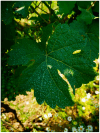Antioxidant, Nutritional Properties, Microbiological, and Health Safety of Juice from Organic and Conventional 'Solaris' Wine (Vitis vinifera L.) Farming
- PMID: 39456467
- PMCID: PMC11503995
- DOI: 10.3390/antiox13101214
Antioxidant, Nutritional Properties, Microbiological, and Health Safety of Juice from Organic and Conventional 'Solaris' Wine (Vitis vinifera L.) Farming
Abstract
This study investigated the technological parameters, microbiological, and functional properties of juice from Solaris grapes grown under conventional and organic farming systems to assess how these cultivation methods influence juice quality. The one-year study focused on key aspects such as the levels of health-promoting polyphenols, the presence of mycotoxins, and pesticide residues. Organic grapes showed greater bacterial and fungal diversity, with significant differences in dominant genera. Sphingomonas and Massilia were the predominant bacteria across both systems, while Erysiphe was more common in conventional grapes, and Aureobasidium was abundant in both. Despite the presence of genes for mycotoxin production, no mycotoxins were detected in the juice or pomace. Organic juice exhibited significantly higher levels of polyphenols, leading to enhanced antioxidant properties and improved technological characteristics, including lower acidity and higher nitrogen content. However, residues of sulfur and copper, used in organic farming, were detected in the juice, while conventional juice contained synthetic pesticide residues like cyprodinil and fludioxonil. These findings highlight that while organic juice offers better quality and safety in terms of polyphenol content and antioxidant activity, it also carries risks related to residues from organic treatments, and conventional juice poses risks due to synthetic pesticide contamination.
Keywords: antioxidant activity; grapes; microbiome; mycotoxins; organic farming; plant protection; polyphenols.
Conflict of interest statement
The authors declare no conflicts of interest.
Figures








Similar articles
-
Carotenoids, total polyphenols and antioxidant activity of grapes (Vitis vinifera) cultivated in organic and conventional systems.Chem Cent J. 2012 Jul 4;6(1):66. doi: 10.1186/1752-153X-6-66. Chem Cent J. 2012. PMID: 22762349 Free PMC article.
-
Farming System Effect on the Incidence of Aspergillus carbonarius on Kotsifali Grapes and Ochratoxin A Occurrence in Wines of Crete.J Food Prot. 2020 Oct 1;83(10):1796-1800. doi: 10.4315/JFP-20-133. J Food Prot. 2020. PMID: 32502241
-
A Comparative Analysis of Microbe-Based Technologies Developed at ICAR-NBAIM Against Erysiphe necator Causing Powdery Mildew Disease in Grapes (Vitis vinifera L.).Front Microbiol. 2022 May 17;13:871901. doi: 10.3389/fmicb.2022.871901. eCollection 2022. Front Microbiol. 2022. PMID: 35663883 Free PMC article.
-
Grape juice or wine: which is the best option?Crit Rev Food Sci Nutr. 2020;60(22):3876-3889. doi: 10.1080/10408398.2019.1710692. Epub 2020 Jan 10. Crit Rev Food Sci Nutr. 2020. PMID: 31920107 Review.
-
Melatonin in grapes and grape-related foodstuffs: A review.Food Chem. 2017 Sep 15;231:185-191. doi: 10.1016/j.foodchem.2017.03.137. Epub 2017 Mar 24. Food Chem. 2017. PMID: 28449995 Review.
Cited by
-
Enhanced Extraction of Polyphenols, Physicochemical Properties, and Microbial Control in Vitis vinifera L. Juice Using Ultrasound-Assisted Maceration.Molecules. 2025 Jan 27;30(3):587. doi: 10.3390/molecules30030587. Molecules. 2025. PMID: 39942690 Free PMC article.
References
-
- Francesca N., Sannino C., Settanni L., Corona O., Barone E., Moschetti G. Microbiological and chemical monitoring of Marsala base wine obtained by spontaneous fermentation during large-scale production. Ann. Microbiol. 2014;64:1643–1657. doi: 10.1007/s13213-014-0808-0. - DOI
-
- Kántor A., Mareček J., Ivanišová E., Terentjeva M., Kačániová M. Microorganisms of grape berries. Proc. Latv. Acad. Sci. Sect. B. 2017;71:502–508. doi: 10.1515/prolas-2017-0087. - DOI
-
- Fernández-Cruz M.L., Mansilla M.L., Tadeo J.L. Mycotoxins in fruits and their processed products: Analysis, occurrence and health implications. J. Adv. Res. 2010;1:113–122. doi: 10.1016/j.jare.2010.03.002. - DOI
LinkOut - more resources
Full Text Sources

